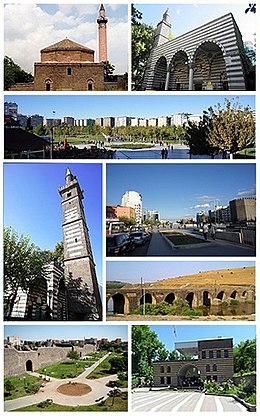Diyarbakır, Turkey
| Diyarbakır |
|
|---|---|
| Metropolitan municipality | |

Top left: Ali Pasha Mosque, Top right: Nebi Mosque, 2nd: Seyrangeha Park, 3rd left: Dört Ayaklı Minare Mosque, 3rd upper right: Deriyê Çiyê, 3rd lower right: On Gözlü Bridge (or Silvan Bridge), over Tigris River, Bottom left: Diyarbakır City Wall, Bottom right: Gazi Köşkü (Veterans Pavilion)
|
|
| Coordinates: 37°55′N 40°14′E / 37.91°N 40.24°E | |
| Country |
|
| Region | Southeastern Anatolia |
| Province | Diyarbakır |
| Government | |
| • Mayor | Cumali Atilla (State-appointed caretaker) |
| Elevation | 675 m (2,215 ft) |
| Population (2013) | |
| • Metropolitan municipality | 930,266 |
| • Metro | 1,300,000 |
| Time zone | FET (UTC+3) |
| Postal code | 21x xx |
| Area code(s) | 412 |
| Licence plate | 21 |
| Website | www.diyarbakir-bld.gov.tr |
Diyarbakır (Syriac: ܐܡܝܕܐ, translit. Amida, Kurdish: Amed) is one of the largest cities in southeastern Turkey. Situated on the banks of the Tigris River, it is the administrative capital of the Diyarbakır Province. With a population of about 930,000 it is the second largest city in Turkey's Southeastern Anatolia Region, after Gaziantep.
Diyarbakır is considered the unofficial capital of so-called Turkish Kurdistan. As such, it has been a focal point for conflict between Turkey's government and Kurdish insurgent groups.
The name Diyarbakır (Arabic: دیار بکر, Diyaru Bakr, which means the Land of Bakir; Armenian: Տիգրանակերտ, Tigranakert;Ancient Greek: Άμιδα, Amida; Ottoman Turkish: دیاربکر, Diyâr-ı Bekr; Syriac: ܐܡܝܕ) is inscribed as Amid on the sheath of a sword from the Assyrian period, and the same name was used in other contemporary Syriac and Arabic works. The Romans and Byzantines called the city Amida. Another medieval use of the term as Amit is found in Empire of Trebizond official documents in 1358. Among the Artukid and Akkoyunlu it was known as "Black Amid" (Kara Amid) for the dark color of its walls, while in the Zafername, or eulogies in praise of military victories, it is called "Black Fortress" (Kara Kale). In the Book of Dede Korkut and some other Turkish works it appears as Kara Hamid.
...
Wikipedia

